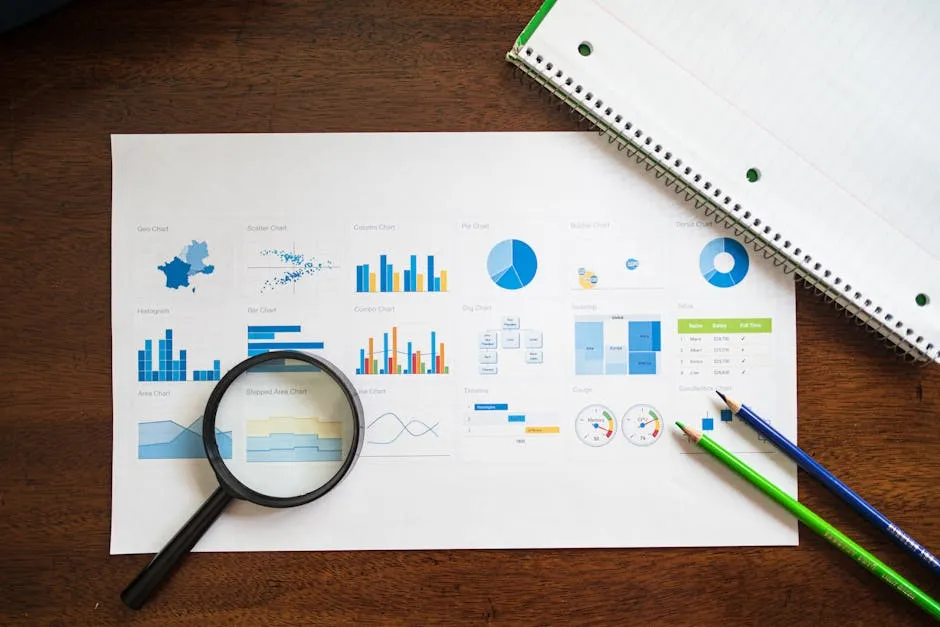Introduction
Scatter charts are powerful tools for data visualization. They help reveal relationships between two continuous variables. This article aims to explore the concept, construction, and uses of scatter charts. Their significance spans various fields like science, business, and social sciences, making them essential for data analysis.
Summary and Overview
A scatter chart, or scatter plot, visually represents the relationship between two continuous variables in a dataset. It features a Cartesian coordinate system with an X-axis and a Y-axis. The X-axis typically shows the independent variable, while the Y-axis displays the dependent variable. Each data point is plotted on this grid, allowing for the identification of potential relationships, patterns, and trends between the variables.
Scatter charts excel at illustrating correlations, making them versatile for data analysis. They can highlight linear or nonlinear relationships and reveal clusters or outliers within the data. This effectiveness in visualizing complex data sets is why scatter charts are widely used across various disciplines, aiding analysts and researchers in making informed decisions based on observed patterns. For more insights on correlation, check out our detailed guide.

To make your scatter charting experience even more powerful, consider using a Graphing Calculator. It can handle complex calculations and help you visualize your data in ways you never thought possible. Don’t let manual calculations hold you back from spotting those critical trends!
Understanding correlation is key for analyzing relationships in scatter charts. Learn more about correlation.
What is a Scatter Chart?
A scatter chart, often called a scatter plot, is a graphical representation that illustrates the relationship between two variables. It uses the Cartesian coordinate system, where each point represents a pair of values—one from the independent variable and one from the dependent variable. The X-axis represents the independent variable, while the Y-axis represents the dependent variable.
Understanding the distinction between independent and dependent variables is crucial. The independent variable is the one you manipulate or control, while the dependent variable is what you measure or observe. For example, in a study examining the impact of study hours on exam scores, study hours would be the independent variable plotted on the X-axis, and exam scores would be the dependent variable on the Y-axis. For a deeper understanding of these concepts, refer to our comprehensive guide on independent and dependent variables.

To keep your notes organized while analyzing data, consider using a Notebook for Data Analysis. It provides the perfect space to jot down your observations, calculations, and ideas without losing track of your thought process!
Understanding independent and dependent variables is essential for effective data analysis. Explore more about independent and dependent variables.
Scatter charts are particularly useful for identifying correlations, whether positive or negative. A positive correlation means that as one variable increases, the other tends to increase as well. Conversely, a negative correlation indicates that as one variable increases, the other decreases. By visualizing these relationships, scatter charts provide insights that are valuable for decision-making processes in various fields, from scientific research to business analytics.
Basic Concepts of Scatter Charts
Variables and Axes
In scatter charts, two types of variables are key: independent and dependent. The independent variable is plotted on the X-axis, while the dependent variable is shown on the Y-axis. This setup establishes a clear visual framework. For example, if you’re studying how temperature affects ice cream sales, temperature would be the independent variable, and sales would be the dependent one. This distinction helps in understanding how changes in one variable can influence the other.

Data Points and Markers
Data points in a scatter chart represent pairs of values. Each point corresponds to a unique combination of the independent and dependent variables. Markers, such as dots or squares, visualize these points on the chart. The position of each marker indicates its value along the X and Y axes. These markers can vary in size or color to represent additional data dimensions, enhancing the chart’s informational depth. By plotting multiple data points, you can quickly identify patterns and trends within your dataset.
Visualizing your data using scatter charts can reveal insights you might otherwise miss! To enhance your data visualization skills, consider reading a Data Visualization Book. It provides practical tips and techniques to create compelling visual stories from your data!
Capturing Relationships: Distinct Features
Understanding correlations is essential when interpreting scatter charts. You often encounter two main types: linear and nonlinear correlations. A linear correlation creates a straight line, indicating a consistent relationship between variables. In contrast, a nonlinear correlation forms a curve, suggesting a more complex connection.
Next, consider the strength of the correlation. A strong correlation means data points cluster closely around a trend line. This indicates a clear relationship. On the other hand, a weak correlation shows data points spread out, making it harder to identify a pattern.
Additionally, correlations can be categorized as positive or negative. A positive correlation implies that as one variable increases, the other also increases. For instance, more hours studied typically lead to higher exam scores. Conversely, a negative correlation indicates that as one variable increases, the other decreases. An example is the relationship between outdoor temperature and the amount of heating used in a building. Recognizing these relationships helps in drawing meaningful conclusions from your data.

Applications and Importance of Scatter Charts
Scientific Research and Experimentation
In scientific research, scatter charts play a vital role in visualizing experimental data. Researchers use these charts to present findings and validate hypotheses effectively. For instance, they can illustrate how varying ingredient amounts affect a chemical reaction. By plotting the results, scientists can quickly identify trends, correlations, and potential outliers in their data. This visualization aids in understanding the relationships between variables, ultimately supporting informed conclusions.

Business Analytics
In the realm of business analytics, scatter charts are indispensable for decision-making. They help analysts visualize relationships between various business metrics, such as marketing expenditure and sales figures. By examining these correlations, businesses can determine the effectiveness of their marketing strategies. For example, a scatter chart might reveal that increased spending on advertising correlates with higher sales, guiding future investments. Ultimately, these insights drive strategic decisions and enhance overall performance. To learn more about how data can drive strategic decisions, read about business analytics.
To facilitate your analysis, having the right tools is essential. Consider investing in Statistical Analysis Software. This software can streamline your data analysis process and provide advanced insights that manual methods may overlook!
Business analytics is crucial for making data-driven decisions. Discover the power of business analytics.
Social Sciences
Scatter charts are also valuable in social sciences, allowing researchers to explore complex social phenomena. For example, they can illustrate the relationship between income levels and education attainment in a community. By plotting these variables, researchers can identify trends that may not be immediately apparent from raw data. This visual representation facilitates better understanding of societal issues, helping to inform policy decisions and social programs aimed at improving community well-being. For more on statistical methods in social sciences, check out our guide on Agresti’s statistical methods.

To enhance your understanding of these topics, consider picking up a R Programming for Data Science Book or a Python for Data Analysis Book. These resources provide foundational knowledge and practical skills to make the most of your data!
Statistical methods are key in social sciences research. Explore Agresti’s methods for effective analysis.
Environmental Studies
Scatter charts are essential in environmental studies. They effectively display relationships between ecological variables. For instance, researchers may analyze the impact of temperature on species diversity. Each point on the scatter chart represents a unique observation, such as temperature readings and species counts. This visual format allows scientists to quickly identify patterns. Are species counts higher at certain temperatures? Are there outliers indicating unusual conditions? By using scatter charts, researchers can assess ecological data more efficiently and make informed decisions regarding conservation efforts and environmental policies.

Steps to Constructing a Scatter Chart
Data Selection and Preparation
Start by identifying your independent and dependent variables. This step is crucial for meaningful analysis. Next, collect pairs of data points that correspond to these variables. Ensure the data is complete and accurate. After gathering your data, review it for missing values or inconsistencies. Remove any outliers that could skew results. Finally, organize your data in a structured format, such as a spreadsheet, to facilitate easy plotting. With well-prepared data, you’re ready to create a clear and impactful scatter chart.

Axis Scaling and Ranges
Scaling your axes is vital for accurate representation. Choose an appropriate scale for both the X and Y axes. Common options include linear and logarithmic scales. Determine the range for each axis based on your data. Ensure that the range encompasses all your data points without excessive whitespace. This careful scaling helps highlight trends and relationships effectively, making your scatter chart more informative and visually appealing.
Data Visualization and Interpretation
To plot your data points, place each point at the intersection of its X and Y values. Use distinct markers to represent different groups or categories within your data. After plotting, take a moment to interpret the results. Look for trends, clusters, or correlations between the variables. Are the data points concentrated in specific areas? Understanding these visual cues can provide valuable insights into the relationships present in your data, guiding further analysis or decision-making.
Labels, Titles, and Context
Clear labeling is essential for effective communication in scatter charts. Label the X and Y axes with relevant units of measurement. A descriptive title helps viewers understand the chart’s purpose at a glance. Consider adding annotations or reference lines for additional context. These elements enhance clarity, enabling your audience to grasp the significance of the data quickly. Properly labeled charts foster better understanding and engagement with your findings.
Interpretation of Scatter Charts
Identifying Patterns and Trends
When you look at a scatter chart, focus on clusters of data points. These clusters often indicate relationships between variables. For instance, if the points trend upwards, it suggests a positive correlation. Conversely, a downward trend may imply a negative correlation. By observing how data points are organized, you can identify patterns. Are they scattered widely, or do they form a clear line? Understanding these trends helps you grasp the underlying relationships in your data, making it easier to draw conclusions.

Assessing Correlations
To evaluate correlations in a scatter chart, consider both strength and direction. A strong correlation presents data points close to a trend line, indicating a reliable relationship. A weak correlation shows points more spread out, suggesting less certainty. Additionally, observe the direction of the trend line. An upward slope indicates a positive correlation, while a downward slope indicates a negative one. By assessing these factors, you can determine how closely related the variables are and predict potential outcomes based on the data.
Identifying Outliers
Outliers are data points that fall far outside the general trend of the scatter chart. They can significantly impact your analysis. Identifying these points is crucial because they may represent errors, unique cases, or valuable insights. For instance, an outlier in a sales dataset might indicate an unusually high sale that warrants further investigation. By understanding the context of these outliers, you can make better interpretations of your overall data set.
Please let us know what you think about our content by leaving a comment down below!
Thank you for reading till here 🙂 And remember, while diving into data analysis, a good pair of Noise-Cancelling Headphones can be your best friend. They help you focus amidst the chaos of life while you crunch those numbers!
All images from Pexels




